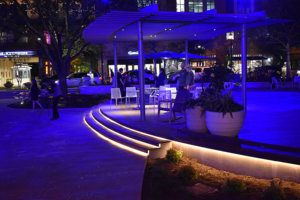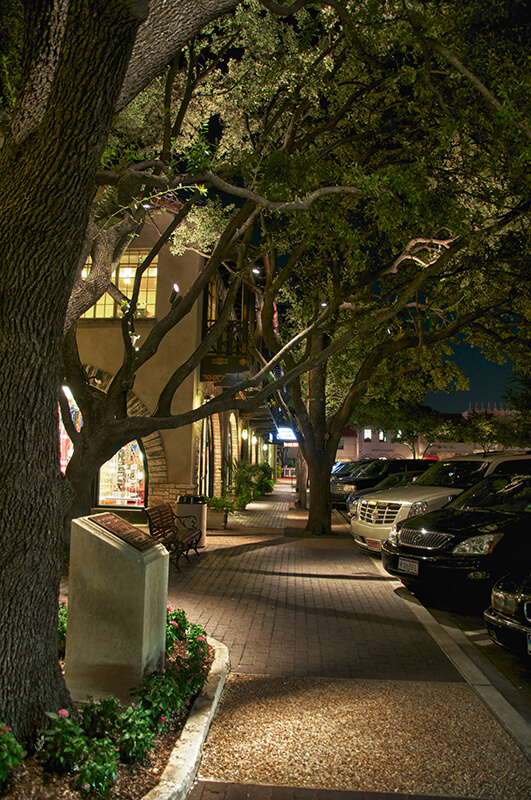As summer approaches, indoor spaces extend into the outdoors and many welcome the opportunity to spend more time outside. Designing outdoor environments to enhance the users’ experience can provide comfort, enjoyment and function. Lighting is an essential tool for elevating those spaces and achieving design goals.
When lighting an outdoor environment, like a park, mixed-use center or community area, safety and security are the first priority and often the focus when designing the lighting. However, it’s possible to blend the need for safety with strategic techniques to enhance an outdoor space.
With the evolution of LEDs and advancements in fixture designs, exterior lighting can be taken beyond the use of poles and bollards. The pallet of options now allows for a more artistic and nuanced approach.
The Lighting Practice (TLP) Principal, Jered Widmer, offers six tips and techniques to elevate an exterior environment with lighting.

Liberty Mutual, Plano, TX – Photo provided courtesy of OMNIPLAN
1. It’s not always about seeing the light fixtures, sometimes it’s about the effect
By strategically placing light within the landscape or hardscape elements, it can reveal texture, colors and depth in those spaces. This requires careful coordination with the landscape architect to successfully integrate fixtures in benches, planter walls, tree canopies, and art elements.
“Lighting should complement the design and not stand out as an afterthought”, advises Jered Widmer.
Lenfest Plaza, Philadelphia, PA – Photo by TLP (Stephen Hoppe)
2. Light verticals and perimeters
“Light levels on the ground aren’t the only way to make a space feel safe and inviting”, explains Jered, “Lighting verticals and perimeters can provide a sense of safety and define the space”.
Perception of a nighttime environment is strongly impacted by what’s in the viewer’s sightlines – thinking about how people move through and view the space can influence where to apply light.
Pentagon Row, Arlington, VA – Photo by HB Field Studio (Holly Burke)
3. Dimming
When it comes to designing an outdoor environment, many people don’t think to include dimming in their design.
“By zoning and dimming specific light fixtures, you can strike a better balance in an outdoor lighting environment”, says Jered. “We see the programming for outdoor spaces being more varied. Dimming provides more flexibility for the use of these spaces”.
Dimming can also mitigate glare and brightness, making the space more comfortable and enjoyable.
Highland Park Village, Highland Park, TX – Photo by TLP (Jered Widmer)
4. Moonlighting
Moonlighting is a technique that adds a whimsical, fun touch to an outdoor space. By placing the light source within the tree canopy and casting the light downward, it mimics the effect of moonlight shining through tree branches.
This technique is particularly successful in Texas landscape designs, because of the live oaks common in the region. The Texas Live Oak’s twisting, low-hanging limbs provide a perfect canopy to install lighting to create a moonlight effect.

Market Street at The Woodlands, Woodland, TX – Photo taken by TLP (Ryan Conover)
5. Integrating color-changing elements
Tap into the community where your project is located with color-changing light elements in your space. Use the colors of a local sports team or school, or colors signifying certain holidays, as a way of partaking in and supporting the community.
“This conveys a connection”, says Jered, “demonstrating the owner/end-user cares about and wants to be part of the community”.
While color-changing lighting can be fun, Jered suggests that the execution should be used intentionally and sparingly, allowing for the light to always revert to white.
Market Street at The Woodlands, Woodland, TX – Photo taken by TLP (Ryan Conover)
6. Catenary lighting
Although festoon lighting will always be a popular choice for making outdoor spaces feel intimate and lively, Jered highly suggests catenary lighting.
“If you’re looking for a more unique strategy that can add more character into the space, catenary is a different approach to overhead lighting,” says Jered.
Catenary lighting not only saves ground space by suspending the lights overhead but allows for more creativity in your design because of the variety of fixtures you can suspend that support the desired aesthetic.
In order achieve the design goals of the space, it is crucial for the lighting designer to work closely with the landscape architect and design team.
Two challenges for designing exterior environments are strict energy codes and new city ordinances. A lighting designer is able to achieve the desired aesthetic of an outdoor space, while also mitigating technical constraints and challenges.
Now more than ever, exterior environments can be designed more creatively, because of advances in technology and the desire to make outdoor spaces transformative. Lighting elevates and compliments the landscape and architects visions, making outdoor spaces memorable and enjoyable.









